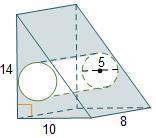
Mathematics, 15.10.2019 00:10 mayasiegel5234
Which expression represents the volume, in cubic units, of the shaded region of the composite figure?
a) 1/2(14)(10)(8) – π(2.52)(8)
b) 1/2(14)(10)(8) + π(2.52)(8)
c) 1/3(1/2)(10)(8)(14) – π(2.52)(8)
d) 1/3(1/2)(10)(8)(14) + π(2.52)(8)


Answers: 3


Another question on Mathematics

Mathematics, 21.06.2019 16:20
Apolynomial function has a root of –6 with multiplicity 1, a root of –2 with multiplicity 3, a root of 0 with multiplicity 2, and a root of 4 with multiplicity 3. if the function has a positive leading coefficient and is of odd degree, which statement about the graph is true?
Answers: 2

Mathematics, 21.06.2019 16:50
Kapil needed to buy a long wooden beam. he went to two sawmills that each charge an initial fee plus an additional fee for each meter of wood. the following equation gives the price (in dollars) of a wooden beam from the first sawmill as a function of its length (in meters). p = 5+20xp=5+20x
Answers: 1

Mathematics, 21.06.2019 21:00
Dean and karlene get paid to write songs. dean is paid a one-time fee of $20 plus $80 per day. karlene is paid a one-time fee of $25 plus $100 per day. write an expression to represent how much a producer will pay to hire both to work the same number of days on a song.
Answers: 1

Mathematics, 21.06.2019 21:30
In a test for esp (extrasensory perception), the experimenter looks at cards that are hidden from the subject. each card contains either a star, a circle, a wave, a cross or a square.(five shapes) as the experimenter looks at each of 20 cards in turn, the subject names the shape on the card. when the esp study described above discovers a subject whose performance appears to be better than guessing, the study continues at greater length. the experimenter looks at many cards bearing one of five shapes (star, square, circle, wave, and cross) in an order determined by random numbers. the subject cannot see the experimenter as he looks at each card in turn, in order to avoid any possible nonverbal clues. the answers of a subject who does not have esp should be independent observations, each with probability 1/5 of success. we record 1000 attempts. which of the following assumptions must be met in order to solve this problem? it's reasonable to assume normality 0.8(1000), 0.2(1000)%30 approximately normal 0.8(1000), 0.2(1000)% 10 approximately normal srs it is reasonable to assume the total number of cards is over 10,000 it is reasonable to assume the total number of cards is over 1000
Answers: 1
You know the right answer?
Which expression represents the volume, in cubic units, of the shaded region of the composite figure...
Questions






















